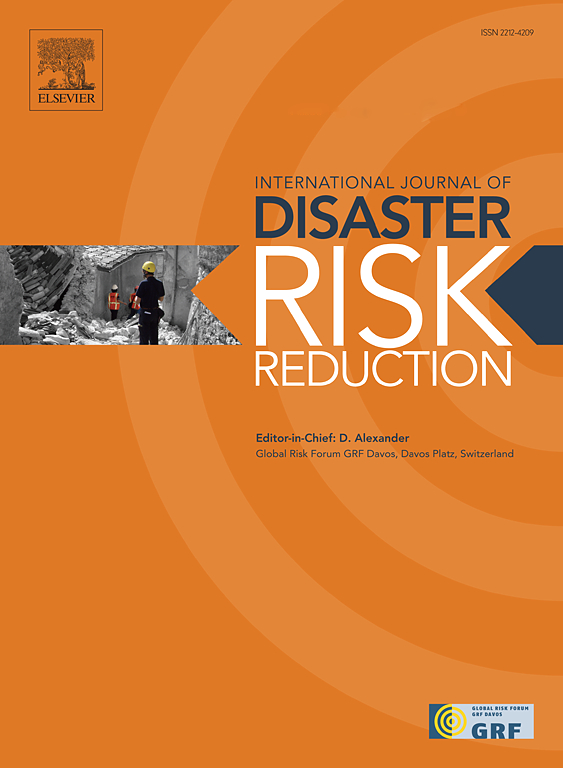语言作为沟通早期预警信息的催化剂的作用:以南非盖伯哈Walmer机场谷非正式住区为例研究
IF 4.5
1区 地球科学
Q1 GEOSCIENCES, MULTIDISCIPLINARY
International journal of disaster risk reduction
Pub Date : 2025-05-29
DOI:10.1016/j.ijdrr.2025.105573
引用次数: 0
摘要
有效的灾害沟通在南非等多语言和多文化环境中至关重要,在南非,信息传播中的语言障碍和差异可能会加剧社区在紧急情况下的易感性。了解与灾害有关的通信是至关重要的,特别是对于像科萨语的沃尔默机场谷盖伯哈非正式定居点居民这样的边缘化人群。本研究探讨了语言在早期预警系统中的功能,并分析了改善灾难沟通的选择,以保证沃尔默机场谷的清晰度、可及性和文化相关性,特别强调了多语言沟通的功效。从2024年7月5日至8月25日,对沃尔默机场谷科萨语社区的300名参与者进行了定量调查。描述性和推断性统计,包括卡方检验、回归分析和方差分析,被用来检验人口统计、对沟通渠道的信任和信息清晰度之间的相关性。研究表明,90%的参与者理解灾害概念;然而,只有85.4%的人遇到了早期预警信息。虽然86%的个人拥有移动电话,但只有30%的人通过这种媒介收到早期预警。社区广播是最可靠的媒体,信任度为88%。信息清晰度与受教育程度之间的关系较强,卡方值为96.282 (p <;0.001)。相反,工作职位与沟通信任之间的相关性更强,卡方值为114.527 (p <;0.001)。回归分析表明,信息清晰度对信息效能有显著影响,回归系数为0.489 (p <;0.001)。这些研究结果表明,灾难通信需要适合文化差异的清晰、有组织的消息传递,以及更好的移动网络基础设施,以最大限度地提高其成功率。该研究提供了关于如何将定制通信与基于语言的无障碍服务结合起来以减少灾害风险的重要发现。本文为加强受威胁社区的准备和反应能力提供了有益的指导。本文章由计算机程序翻译,如有差异,请以英文原文为准。
The role of language as a catalyst in communicating early warning messages: a case study in Walmer Airport Valley informal settlement, Gqeberha, South Africa
Efficient disaster communication is crucial in multilingual and multicultural contexts such as South Africa, where linguistic obstacles and disparities in information dissemination can intensify community susceptibility during emergencies. Comprehending disaster-related communications is essential, especially for marginalised populations like Xhosa-speaking Walmer Airport Valley Gqeberha informal settlement residents. This study investigates the function of language in early warning systems and analyses options for improving disaster communication to guarantee clarity, accessibility, and cultural relevance at Walmer Airport Valley, with a particular emphasis on the efficacy of multilingual communication. A quantitative survey was administered to 300 participants from the Xhosa-speaking community in Walmer Airport Valley from 5 July to August 25, 2024. Descriptive and inferential statistics, encompassing chi-square tests, regression analysis, and ANOVA, were employed to examine the correlations among demographics, trust in communication channels, and message clarity. The research indicated that 90 % of participants comprehended disaster concepts; however, only 85.4 % encountered early warning messages. Although 86 % of individuals own mobile phones, only 30 % received early warnings through this medium. Community radio was the most reliable medium, with a trust level of 88 %. The relationship between message clarity and education level was strong, with a Chi-square value of 96.282 (p < 0.001). In contrast, the relationship between the work position and trust in communication demonstrated an even stronger correlation with a Chi-square value of 114.527 (p < 0.001). The regression analysis showed that message clarity powerfully affected message efficacy since the regression coefficient was 0.489 (p < 0.001). These research outcomes show that disaster communication needs clear, organised messaging that suits cultural variations and a better mobile network infrastructure to maximise its success rate. The research delivers crucial findings regarding how to combine customised communications with language-based accessibility services to reduce disaster risks. The article provides useful guidance for enhancing the preparedness and response capabilities of communities under threat.
求助全文
通过发布文献求助,成功后即可免费获取论文全文。
去求助
来源期刊

International journal of disaster risk reduction
GEOSCIENCES, MULTIDISCIPLINARYMETEOROLOGY-METEOROLOGY & ATMOSPHERIC SCIENCES
CiteScore
8.70
自引率
18.00%
发文量
688
审稿时长
79 days
期刊介绍:
The International Journal of Disaster Risk Reduction (IJDRR) is the journal for researchers, policymakers and practitioners across diverse disciplines: earth sciences and their implications; environmental sciences; engineering; urban studies; geography; and the social sciences. IJDRR publishes fundamental and applied research, critical reviews, policy papers and case studies with a particular focus on multi-disciplinary research that aims to reduce the impact of natural, technological, social and intentional disasters. IJDRR stimulates exchange of ideas and knowledge transfer on disaster research, mitigation, adaptation, prevention and risk reduction at all geographical scales: local, national and international.
Key topics:-
-multifaceted disaster and cascading disasters
-the development of disaster risk reduction strategies and techniques
-discussion and development of effective warning and educational systems for risk management at all levels
-disasters associated with climate change
-vulnerability analysis and vulnerability trends
-emerging risks
-resilience against disasters.
The journal particularly encourages papers that approach risk from a multi-disciplinary perspective.
 求助内容:
求助内容: 应助结果提醒方式:
应助结果提醒方式:


